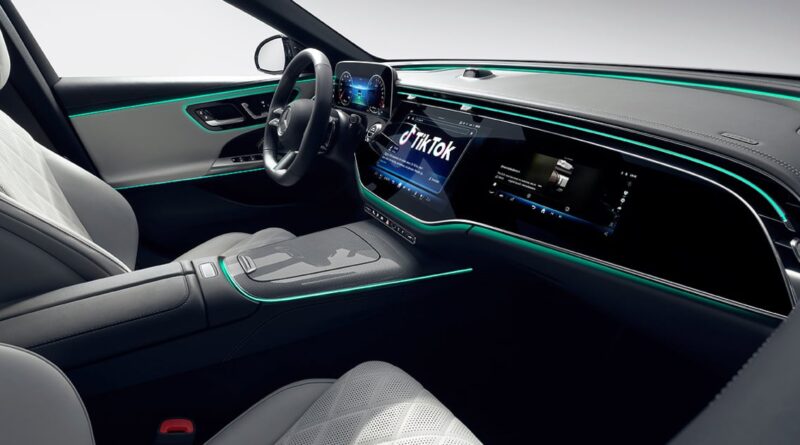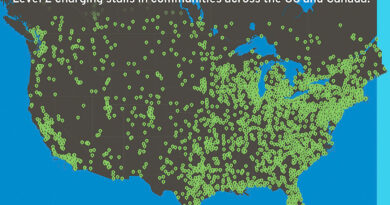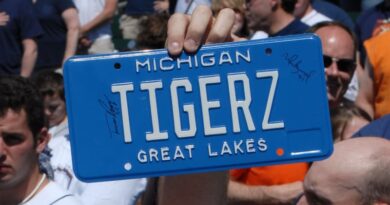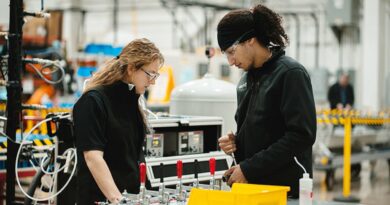As infotainment systems integrate Zoom and TikTok, the question remains: Why?
For businesses, Zoom rapidly became the blessing and the bane of the pandemic as companies pivoted to conducting hours of daily meetings virtually. It kept operations going, but there was no escape.
Automakers noticed, and now they are bringing the office into the car by making Zoom available on dashboard screens.
Both Mercedes-Benz and Volkswagen Group, maker of Audi, Porsche, Lamborghini and Bentley, are now integrating third-party video apps including Zoom and TikTok into their vehicle infotainment systems but with safety precautions that the automakers say will prevent distracted driving.
“There is a demand from our customers that they would like to use conferencing tools” in the car, said Alexander Schoenhals, a Mercedes-Benz engineer who worked on the third-party app integrations.
German brands are scrambling to compete with U.S. luxury leader Tesla Inc., which announced in December that an over-the-air software update would add Zoom conferencing using a camera and microphone in the car.
Safety advocates are questioning the logic behind these integrations.
With traffic fatalities at a 16-year high, they are concerned that putting these types of apps in cars sends the wrong message about driver distraction.
“At the end of the day, we want drivers particularly focused on driving,” said Russ Martin, senior director of policy and government relations at the Governors Highway Safety Association.
Mercedes-Benz, Volkswagen and other automakers have until now mostly ceded the applications experience to Apple CarPlay and Android Auto. More than 80 percent of new cars sold last year support Apple CarPlay, which uses the car’s infotainment system as an extended cellphone display. Toyota resisted until the 2019 model year but ultimately agreed to support Apple CarPlay. GM is planning to phase out the systems in its future electric vehicles.
At present, drivers can either manually or wirelessly connect their phones and display mobile apps to play music, view maps and make calls on the infotainment system.
The new Mercedes and Volkswagen integrations will allow drivers to download and navigate applications using an interface built in partnership with other applications optimized for use in the car. Both will still support Apple CarPlay and Android Auto.
“If you’re using Android Auto or Apple CarPlay, then you’re kind of limited” for use of applications, Schoenhals said. With the new integrations, customers “can use it in a better manner.”
The automakers say the integrations will make application use more seamless and expansive, giving occupants capabilities they would not otherwise have — like viewing TikTok content. Proponents say the embedded applications make for a safer and less manual experience, discouraging drivers from using their phones.
“We are convinced that the in-car app usage, in contrast to simple mirroring of apps, is more intense, with higher retention and interaction rates for an overall better customer experience,” said Elise Pham, a spokesperson for Cariad, Volkswagen Group’s software designer.
The initial rollouts will cover the 2024 Mercedes-Benz E-Class and new Audi models.
A “superscreen” in the new E-Class spans the length of the dashboard and features three screens for the driver and passenger. It has 5G connectivity and a third-party app store from which users can download applications such as TikTok, Zoom and Angry Birds.
Mercedes has a number of safety features built into its integrations. Drivers will not be able to access videos or videoconferencing on their screens unless the car is parked, though audio calls will function when the car is in motion. Passengers will be able to view videos on their screens with the car in motion.
A selfie camera at the top of the dashboard in the E-Class can be used to participate in conferences. Another camera detects when a driver views the passenger screen for more than a couple of seconds when the car is going more than about 3 mph. In that case, the visibility of the passenger screen from the driver’s side is reduced.
Volkswagen’s driver-side video applications in the new Audi models also are only accessible when the vehicle is parked, Pham said. Models with a passenger display will play videos when the car is in motion, but the passenger screens are blocked by a “special foil that makes their content invisible to the driver,” the company said.
Still, safety advocates question the broader effects of embedding entertainment systems in cars.
In 2021, more than 3,500 people were killed in motor vehicle accidents involving distracted drivers, a 12 percent increase from the previous year, according to NHTSA.
Arity, a mobility data and analytics company, found that distracted driving has increased 30 percent over the last four years, while 2021 saw the highest number of fatalities from traffic crashes since 2005.
The majority of states — 31, plus several U.S. territories — ban drivers from using cellphones while driving, and 48 ban texting while driving.
Safety advocates say that while they appreciate automakers building in features to prevent distraction, they don’t understand why companies would take the risk.
“I mean, why is TikTok so important that it needs to be integrated into the vehicle? I have a hard time defending a design choice to make that accessible,” said Jake Nelson, AAA’s director of traffic safety advocacy and research. “If a passenger wants to interact with TikTok,” they “can use their cellphone or smartphone to do that.”
Both automakers said the integrations were created in preparation for further driver-assist functions. They believe these video features eventually will be available for uninhibited use while the vehicle is in fully autonomous motion.
“With increasing automated driving functions, the car is becoming more and more like a second living room — offering customers more time to enjoy and engage with a new digital experience in the car,” a Volkswagen spokesperson said in a statement.
Schoenhals said Mercedes is among the first to deploy Level 3 driver-assistance technology, which allows for conditional automated driving and requires that the driver be ready to take control at any time.
“It’s kind of a logical step to also include video entertainment, videoconferencing into the vehicle because we will be able to see motion pictures while driving,” he said.
But critics say the integrations, available ahead of full automation, could further obscure the capabilities of existing driver-assistance technology.
Americans already deeply misunderstand driver-assist technology, with 1 in 10 telling AAA that they thought they could purchase vehicles that can drive themselves while the driver sleeps. No such vehicle is on the market. Part of this results from confusing driver-assistance system names such as Tesla’s Autopilot, Volvo’s Pilot Assist and Nissan’s ProPilot.
Michael Brooks, executive director for the Center for Auto Safety, described the trend as “future washing.”
“That kind of hype gets into the minds of consumers and owners and people who are buying your cars, and they start to believe that they’re more capable than they are,” he said.
Automakers may have to contend with liability issues if the safety precautions do not work properly, or if the driver’s use of the app integrations plays a role in a crash. The driver could be held liable, but if a plaintiff could make a case that the system was defective or defectively designed, the manufacturer could be liable, too.
Automakers will have to include adequate warnings that the technology is not to be misused and distraction could result in a crash, said Ivan Diamond, a personal injury lawyer in the Bronx, N.Y., who handles car accident cases.
“At what point does” mimicking an at-home entertainment experience “become not just pleasurable but dangerous?” he said. “It’s existing law that has not yet met these facts and circumstances.”
Similarly, if insurance carriers ultimately determine that the new app integrations are correlated with additional risk, drivers might see insurance premiums go up, said Louisa Harbage-Edell, director of product marketing and intelligence at Arity.
Automakers counter that safety is their utmost priority. Mercedes has enhanced its voice-recognition technology and created bigger buttons and other design choices aimed at making the systems more seamless and less distracting. The new screens have myriad features that can keep drivers connected while minimizing safety risks, the company said.
Still, “we’re always afraid of things that are well-intentioned — how drivers might use them out there in the wild,” said Martin of the Governors Highway Safety Association. “We need to look out and try to understand what those impacts might be.”
Source : Autonews.com




